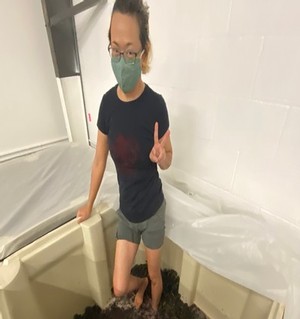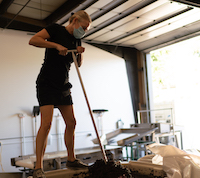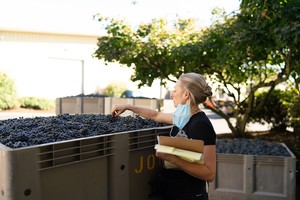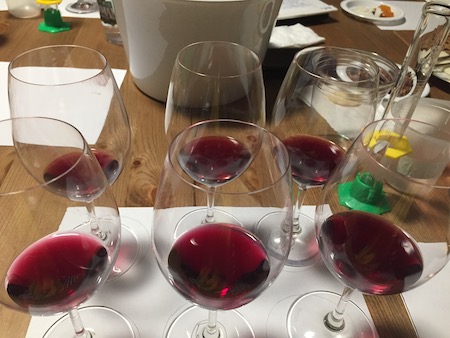My name is Pam and I am a Pinot Geek
This last week I’ve been a pinot geek.
Last Sunday, Kyla (assistant winemaker) and I drank our way through the wines at the Passport to Pinot, which is the last event of the International Pinot Noir Celebration in McMinnville, Oregon. The event brings pinot noir producers and enthusiasts from all over the world to celebrate their love of this finicky yet beguiling grape. I had a huge crush on a 2017 Gevrey-Chambertin offered by Domaine Marc Roy, and not just because they have a female winemaker. The wine was a little lower I alcohol, which was much more agreeable in the heat that we had on Sunday, and it had a gorgeous, supple mouthfeel and perfect balance. Pretty much all of the wines being shown were just lovely.
Throughout the rest of this last week, I’ve been working on my reserve pinot noirs from the 2021 vintage, trying to ascertain which barrels I like better, and which ones will work together to create the single vineyard pinot noirs and the Winemaker Cuvee blend this year. Although, the vintage as a whole is a little boozier than I prefer (just over 14% alcohol), I really like the wines. The vintage reminds me of 2005, with big, expansive tannins, presumably a result of thicker skins from the extreme heat spells we had last summer. This brawny framework supports wines that still have a lot of grace and complexity though. I think the wines will age well.
Probably my favorite wine at the moment is two barrels from Nysa Vineyard. The vines are 20 years old and the block I picked from is planted to Pommard clone pinot noir and is at a higher elevation and east- facing. The wine is just 13.4% alcohol with natural bright acidity, sexy mouthfeel, and such intensely focused bright red fruit flavors. It’s a baby still but, oh my, I can’t wait to see how it evolves.
If the idea of blending sounds interesting, or if you’re a pinot geek like me, consider coming to our last Blending Workshop this year on August 27th. And do check out the single vineyard wines that we currently offer at www.willfulwine.com/shop. If you have questions, don’t hesitate to email us at info@willfulwine.com or call us on 503 577 8982.
Cheers!
Pam Walden, Owner/Winemaker, Willful Wine
What is whole cluster fermentation?
The first time I fermented pinot noir with 100% whole clusters, it was by accident. In 2015 I contracted for just one acre of pinot noir from Lia's Vineyard in the Chehalem Mountain AVA. The vineyard is dry-farmed and it was a warm year and the yield from that acre was almost exactly two tons, which presented me with a bit of a dilemma. One macro fermenter bin holds about a ton and a half of destemmed fruit. If I’d removed the stems the fermenter bins would have been only two thirds full, leaving lots of “head space” above the grapes, which isn’t good for a healthy fermentation. Leaving all the stems on would give me two fairly full fermenters, so instead of running the grapes through the de-stemmer, we just loaded the whole clusters into the fermenters. Which left me with another dilemma… how to get fermentation going?
When you pull the grapes off of the stems, the must is fairly juicy and it’s easy enough to get a punch down tool in there to move the grapes around and get fermentation going. With 100% whole clusters they just kind of sit there: just a huge pile of grapes, so I had to get my shorty shorts on and tread the grapes with my feet to juice them up a bit. Here’s a clip of me doing “pigeage” in 2015.
Two years later, the wine had the additional tannins and spicy flavors that I was expecting but it also had some beautiful floral aromatics. I’ve been choosing to do some degree of whole cluster fermentation most vintages since 2015. The 2019 RIbbon Ridge Pinot Noir has a fair amount of whole clusters in it. I like the additional structure and spicy characteristics it gives the Wadenswil clone pinot noir from that vineyard.

Sign up for our annual Blending Workshop on June 5th and June 10th, and I’ll tell you more about whole cluster fermentation and some of the other choices I make as a winemaker to create the Willful pinot noirs. During the workshop you’ll taste through eight barrel samples and then blend your own bottle of Pinot Noir. Space is limited and by reservation only.
What is native fermentation?

What is native fermentation?
Native fermentation is using the indigenous yeasts from the vineyard to cause primary fermentation i.e. the process where the sugar in the grapes turns to alcohol.
When I’m working with grapes that I know are going to go to the Jezebel pinot noir, I usually inoculate them with yeast. There are a few that I tend to use more often and they’re mostly designed to highlight the fresh fruit flavors of the wine and contribute to a fleshy mouthfeel. The fermentations with these yeasts tend to be fairly uniform each year, and shorter than the wild yeasts I use for the Willful pinot noir. The yeasts are one of the tools that help me to maintain consistency each vintage.
I approach the “willful” pinot noir grapes a little differently. I do a “cold soak” for at least a week, where I keep the grapes in a chiller (usually around 48F). This allows the grape juice to be in contact with the skins for longer and builds structure in the wine, especially the more elegant type of tannins that I prefer. Then I let the fermenters warm up and whatever yeasts came in from the vineyard with them go to work and turn the sugar in to alcohol and the juice into wine. The native ‘wild’ yeasts generally ferment at lower temperatures and take longer to convert all of the sugar in to alcohol and this gives me yet more skin time to build structure in the wine, and also tends make the wines a little more aromatic. Naturally fermented wines tend to have a particularly supple, velvety texture.
I often refer to my wines as children. You have an idea of what you're going to get, but they also often surprise you, and that's one of the things I love about winemaking in general, and about native yeasts. I find they do require a little more work in the winery but I think the variety of terroir and nuance that can be expressed and the impact on the texture is well worth it to me.
What is a grape clone?
 The best way I've found to explain grape clones is comparing grapes to roses. A rose is a rose, but there are different types of roses, and each has their own unique characteristics in how they look and smell. Similarly, the different clones of pinot noir are all pinot noir, but each have their own attributes. Some are more floral and some more spicy. Some are earlier ripening and tend to be more fruit forward, and others are later ripening and are more expressive of some of the secondary flavors in grapes. And.. because it's pinot noir in Oregon, each clone will express itself in a different way depending on the site where it's grown. So.. there's a lot of choices to be made before we even start to get in to what we decide to do in the winery!
The best way I've found to explain grape clones is comparing grapes to roses. A rose is a rose, but there are different types of roses, and each has their own unique characteristics in how they look and smell. Similarly, the different clones of pinot noir are all pinot noir, but each have their own attributes. Some are more floral and some more spicy. Some are earlier ripening and tend to be more fruit forward, and others are later ripening and are more expressive of some of the secondary flavors in grapes. And.. because it's pinot noir in Oregon, each clone will express itself in a different way depending on the site where it's grown. So.. there's a lot of choices to be made before we even start to get in to what we decide to do in the winery!
In 2019 I chose not to blend a Winemaker Cuvee pinot noir, and to focus instead on a three different clones of pinot noir from three very different vineyards and I bottled three "reserve" pinot noirs from 2019, all very much with their own personality:
2019 Dundee Hills Pinot Noir: This is 100% Pommard clone pinot noir from the Balanza Vineyard in the Dundee Hills AVA. Pommard was one of the earliest clones to be planted in Oregon. It tends to be later ripening and maintains acidity pretty well. It has a soft, supple mouthfeel and when grown in the jory soils of the Dundee Hills it shows the typical bright red berry flavors of the AVA with a floral (rose?) aroma and a bright minerality. This wine is pretty and elegant and very feminine. We released this last November to the wine club and it's now available generally on our web site. $35 (47 cases produced)
2019 Ribbon Ridge Pinot Noir: This is 100% Wadensil clone pinot noir from Stewart Vineyard in the Ribbon Ridge AVA. This is the other clone that was planted in the early days of the Oregon wine industry. It tends to be very aromatic with a particularly spicy note. I think it works wonderfully with the darker red fruit flavors and slightly richer tannins of this Ribbon Ridge vineyard. We just released this to the wine club. It will be generally available on the web site in April 2021. $35 (98 cases produced)
2019 "943" clone Pinot Noir: This was my first time working with this newer pinot noir clone. I tried to research it online prior to working with it and found such varying responses to it. It seems to be particularly expressive of the terroir where it's planted. I found it in Jubilee Vineyard in the Eola-Amity Hills. I fermented it as 50% whole clusters which seems to add to what I think is the inherent peppery characteristic. Early on, it tasted almost like a Zweigelt. It's lower in alcohol (just 12.5%), with flinty, mineral characteristics and dark fruits. This is also a new release to the wine club and will be generally available on the web site in April 2021. $35 (47 cases produced).
I love working with (and drinking!) pinot noir because it can be such an expressive grape. At its best it has so many different layers of flavors. I like it when it's not overly showy. I'm not sure who described it this way (maybe Aron?) but I like it: "wines that reveal themselves over time". It doesn't smack you in the face with a big dollop of jammy fruit, or whack you over the head with a 2*4 of oak. It gently allows you to enjoy the floral perfumes, the hint of sandalwood and the suggestion of the freshly dug earth. I love wine that I find myself thinking about the day after I drank them and I find that more with pinot noir than most other varietals. Whatever your reason for drinking pinot noir, I hope you enjoy these. Regardless of clone, terroir or whatever, the only really important thing is - do you like it?
If you're interested in finding out more about pinot noir clones and about how we make decisions in the winery, please join us for our blending workshop on May 15th. We're offering it live at the winery, or online. If you plan to join us online, please sign up by May 1st so we can get the wine to you in time.

Recent Posts
-
August 8, 2023
-
December 10, 2022
-
August 6, 2022
-
March 31, 2022
-
January 17, 2022
-
December 1, 2021
-
June 2, 2021
-
March 31, 2021
-
March 15, 2021
-
March 11, 2021